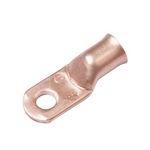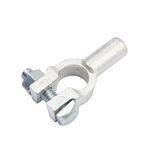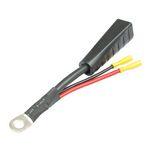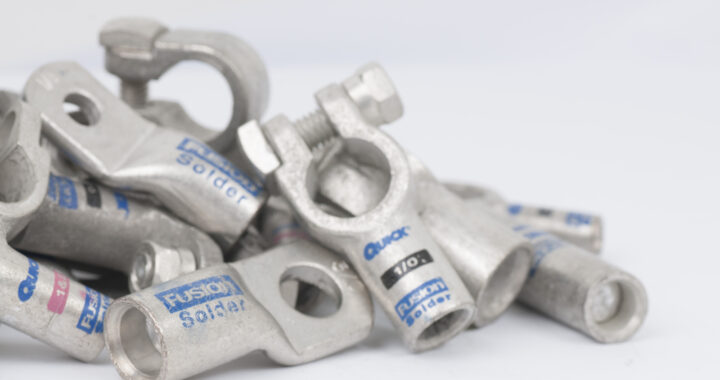There are many types of battery lugs, terminals and tools. In this post we go into detail on the different types of products that allow you to make the most of your battery cable and electrical connections.
Lugs

Battery Lug
Once you have battery cable, battery lugs should be your next step. Battery lugs act as the primary connection between the battery cable and system your battery is powering. Without these lugs, you will not have a proper connection to your battery. Lugs are attached to one end of your battery cable. Crimping or soldering are necessary for some types of lugs, while others provide the ease of manually attaching the battery lug with a hand tool.
A wide variety of lugs are available with the standard being copper lugs. The copper lugs are best used in large gauge applications for either grounding or power draw. These feature a burr-free design for a pleasing finish and are very frequently used in electrical or power applications. An option for tinned copper lugs is available, which adds an extra layer of corrosion protection.
In addition to copper lugs, more unique and specific battery lugs are available. For example, a fusion lug is pre-measured with flux and solder for a quick and easy application. These are ideal for applications with corrosive chemicals or vibration environments as they provide extra protection. For higher voltage applications, a heavy-duty lug would be the best option. For a top post or side mount battery, an anti-rotational crimp lug can lock in 24 different positions. As can be seen, there is a battery lug available for every application.
Battery Terminals
Like a battery lug, a battery terminal is needed to complete your battery cable application. These terminals are the main electrical contact between the battery cable and your battery source. Like the lugs, they will attached to one end of your battery cable. For the finished product, there should be a lug on one end and a battery terminal on the other. A battery terminal can be crimped, soldered, or installed manually using hand tools.

Battery Terminal
In comparison to a battery lug, battery terminals have many more features to keep in mind when selecting the proper product. Options such as material, polarity, barrel size, stud size, angle type, and cable size need to be taken into account. The most common type of battery terminal is a copper terminal often used in medium-duty applications. These are available in straight, parallel, left angle, and right angle options. Once the proper angle is selected, polarity is decided. These are available in positive, negative, and universal types. These allow for higher conductivity and are frequently found in automotive applications including cars, motorcycles, or RVs.
Like battery lugs, more unique terminal options are also available. The fusion terminal line comes pre-measured with flux and solder for easy application. For marine applications, a brass terminal is ideal for high corrosion resistance and special configurations. The lead terminals are utilized in heavy-duty applications where a copper terminal cannot do the job. Del City offers battery terminals in even more options than described above so you can find the perfect terminal for you.
Battery Cable Repair Splices

Battery Cable Repair Splice
If your battery cable gets damaged, there is no need to replace the entire cable. If a small portion of your cable is corroded or damaged, a battery cable repair splice can fix that portion. This kit includes a hex wrench and instructions for easy installation. You simply removed the damaged battery terminal and strip the cable insulation. Next, attach the repair splice slice to the cable and connect the splice back to the battery. The repair splice provides an easier way to solve the damaged cable and still provide a secure fit.
This product is commonly used to fix a wire harness. Vehicles often come equipped with a battery harness that can wear over time. Replacing an entire harness can get pricey and complicated. A battery cable repair splice can replace only the corroded potion without having to remove the entire cable or harness. The repair splice is also available in a heavy-duty option.
Battery Hand Tools
Crimping Tool
When it comes to a complete battery job, manual work may be necessary. This is where a variety of hand tools come in. Del City provides quality cable cutters in order to be sure your battery cable is the length you need. These provide a smooth, clean cut without pinching the wire. A cable stripper may also be necessary when attaching your lug or terminal. These strippers smoothly take off the outer coating of the wire for a proper terminal installation. Finally, when attaching the terminals/lugs, a crimp tool may be necessary. We discussed this earlier where not all terminals require crimping, but it is a good tool to have on hand. This variety of crimp tools makes sure that you have a secure and quality crimp every time.
Still have questions on battery cable or their accessories? Check out “Battery Cable: Uses, Types & Benefits”, “How To Solder Battery Lugs”, and “How To Install Battery Cable Repair Splices.”
Don’t hesitate to reach out to our technical support at 1.800.654.4757 for extra help!
